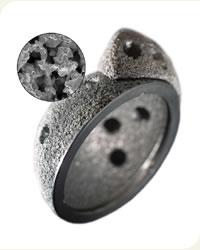Porous Metal
In revision hip surgery, large bone defects and bone stock loss in the pelvis remain a critical problem. The more severe the bone loss of the peri-acetabular structure, the less chance there is of creating long term stability.
Bone graft (including impaction bone grafting), polyethylene cups, plates and screws, and mesh, as well as multi-holed jumbo acetabular shells/cups, have all been used to treat major bone defects following mechanical failure of a total hip replacement (THR).
Jumbo cups made with cobalt chrome alloy have been the workhorse for revision hip surgery over many decades. However, acetabular shells made with porous metals are now popular. The pores in the metal mimic coral and are of a size appropriate for increased bone in-growth. Canine model studies confirmed rapid bone in-growth and early vascularity.
Porous metals are highly bio-compatible and at the same time they are strong, flexible and impart high friction. These metals may be either pure tantalum or pure titanium.
The enhanced surface roughness which is due to the macro texture of these metals provides initial primary stability. Porous metals are unique in that they also have ‘nano scale’ roughness, which allows bone cells to interact with the surface, thus initiating bone cell (osteoblast) adhesion. Fixation can be further enhanced with multiple screw holes in the shells.
In the face of considerable bone stock loss, porous metal shells provide the patient with a chance of long-term fixation. Porous metal augments can also be used for the reconstruction of crevices, large defects and pelvic discontinuity. This reduces the need for bone graft.
Early clinical results showed encouraging results with no mechanical failures or evidence of migration of the shells in the pelvis.
The advent of E-Poly liners provides additional security as they can be cemented into the shell, offering the patient an excellent bearing surface as well.
Porous metals have proved to be a great success in THR.


